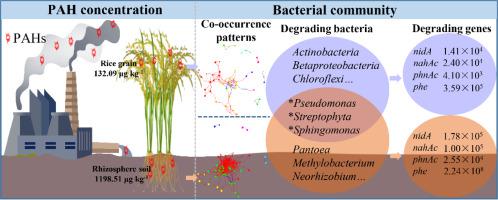当前位置:
X-MOL 学术
›
Appl. Soil Ecol.
›
论文详情
Our official English website, www.x-mol.net, welcomes your feedback! (Note: you will need to create a separate account there.)
Bacterial community and PAH-degrading genes in paddy soil and rice grain from PAH-contaminated area
Applied Soil Ecology ( IF 4.8 ) Pub Date : 2021-02-01 , DOI: 10.1016/j.apsoil.2020.103789 Chao Lu , Yang Hong , Emmanuel Stephen Odinga , Juan Liu , Daniel C.W. Tsang , Yanzheng Gao
Applied Soil Ecology ( IF 4.8 ) Pub Date : 2021-02-01 , DOI: 10.1016/j.apsoil.2020.103789 Chao Lu , Yang Hong , Emmanuel Stephen Odinga , Juan Liu , Daniel C.W. Tsang , Yanzheng Gao

|
Abstract The significance of the bacterial communities and PAH-degrading genes (PDGs) in PAH-contaminated soil has received extensive attention, however, little attention was focused on those in plants grown on contaminated farmland soil. This study aimed to dissect the interactive relationships among PAHs, PDGs, and bacterial communities in the rhizosphere soil and rice grain. Although the concentrations and compositions of PAHs varied greatly, PAHs was the most critical factor in shifting of community in the soil and rice grain. Diversity of the potential PAH-degrading bacteria (PDB) in the rhizosphere soil was higher than that in the rice grain; however, the relative and absolute abundances of PDB in the rhizosphere soil were lower than those in the rice grain. Abundances of four PDGs in the soil were higher than those in the rice grain, and many species of bacteria, including Pseudomonas, Sphingomonas, and so on, which may harbor PDGs were detected. Bacteria in the soil had stronger relationships and were more centrally clustered within the network compared to bacteria in the rice grain. The keystone species (Actiobacteria, Betaproteobacteria, and Chloroflexi) in the soil were different from those (Pseudomonas, Sphingomonas, and Comamonadaceae) in the rice grain. Pseudomonas and Sphingomonas in the rice grain seemed to be the most important bacteria associated with PAH degradation. Overall, these findings provided novel insights into bacterial communities and PDGs in both the soil and plant from the PAH-contaminated paddy soil.
中文翻译:

多环芳烃污染区水稻土和稻谷中的细菌群落和多环芳烃降解基因
摘要 PAH 污染土壤中细菌群落和PAH 降解基因(PDGs)的重要性受到广泛关注,但在污染农田土壤中生长的植物的研究很少受到关注。本研究旨在剖析根际土壤和稻谷中 PAHs、PDGs 和细菌群落之间的相互作用关系。尽管多环芳烃的浓度和组成变化很大,但多环芳烃是土壤和稻谷中群落迁移的最关键因素。根际土壤中潜在多环芳烃降解菌(PDB)的多样性高于稻粒;然而,PDB在根际土壤中的相对丰度和绝对丰度均低于稻谷中的丰度。土壤中4种PDGs的丰度高于稻谷中的丰度,检测到许多可能携带 PDG 的细菌,包括假单胞菌、鞘氨醇单胞菌等。与米粒中的细菌相比,土壤中的细菌具有更强的关系,并且在网络中更集中地聚集。土壤中的关键物种(Actiobacteria、Betaproteobacteria 和 Chloroflexi)与稻粒中的关键物种(假单胞菌、鞘氨醇单胞菌和 Comamonadaceae)不同。稻米中的假单胞菌和鞘氨醇单胞菌似乎是与 PAH 降解相关的最重要的细菌。总的来说,这些发现为来自多环芳烃污染的稻田土壤和植物中的细菌群落和 PDG 提供了新的见解。与米粒中的细菌相比,土壤中的细菌具有更强的关系,并且在网络中更集中地聚集。土壤中的关键物种(Actiobacteria、Betaproteobacteria 和 Chloroflexi)与稻粒中的关键物种(假单胞菌、鞘氨醇单胞菌和 Comamonadaceae)不同。稻米中的假单胞菌和鞘氨醇单胞菌似乎是与 PAH 降解相关的最重要的细菌。总的来说,这些发现为来自多环芳烃污染的稻田土壤和植物中的细菌群落和 PDG 提供了新的见解。与米粒中的细菌相比,土壤中的细菌具有更强的关系,并且在网络中更集中地聚集。土壤中的关键物种(Actiobacteria、Betaproteobacteria 和 Chloroflexi)与稻粒中的关键物种(假单胞菌、鞘氨醇单胞菌和 Comamonadaceae)不同。稻米中的假单胞菌和鞘氨醇单胞菌似乎是与 PAH 降解相关的最重要的细菌。总的来说,这些发现为来自多环芳烃污染的稻田土壤和植物中的细菌群落和 PDG 提供了新的见解。和Commonadaceae)在米粒中。稻米中的假单胞菌和鞘氨醇单胞菌似乎是与 PAH 降解相关的最重要的细菌。总的来说,这些发现为来自多环芳烃污染的稻田土壤和植物中的细菌群落和 PDG 提供了新的见解。和Commonadaceae)在米粒中。稻米中的假单胞菌和鞘氨醇单胞菌似乎是与 PAH 降解相关的最重要的细菌。总的来说,这些发现为来自多环芳烃污染的稻田土壤和植物中的细菌群落和 PDG 提供了新的见解。
更新日期:2021-02-01
中文翻译:

多环芳烃污染区水稻土和稻谷中的细菌群落和多环芳烃降解基因
摘要 PAH 污染土壤中细菌群落和PAH 降解基因(PDGs)的重要性受到广泛关注,但在污染农田土壤中生长的植物的研究很少受到关注。本研究旨在剖析根际土壤和稻谷中 PAHs、PDGs 和细菌群落之间的相互作用关系。尽管多环芳烃的浓度和组成变化很大,但多环芳烃是土壤和稻谷中群落迁移的最关键因素。根际土壤中潜在多环芳烃降解菌(PDB)的多样性高于稻粒;然而,PDB在根际土壤中的相对丰度和绝对丰度均低于稻谷中的丰度。土壤中4种PDGs的丰度高于稻谷中的丰度,检测到许多可能携带 PDG 的细菌,包括假单胞菌、鞘氨醇单胞菌等。与米粒中的细菌相比,土壤中的细菌具有更强的关系,并且在网络中更集中地聚集。土壤中的关键物种(Actiobacteria、Betaproteobacteria 和 Chloroflexi)与稻粒中的关键物种(假单胞菌、鞘氨醇单胞菌和 Comamonadaceae)不同。稻米中的假单胞菌和鞘氨醇单胞菌似乎是与 PAH 降解相关的最重要的细菌。总的来说,这些发现为来自多环芳烃污染的稻田土壤和植物中的细菌群落和 PDG 提供了新的见解。与米粒中的细菌相比,土壤中的细菌具有更强的关系,并且在网络中更集中地聚集。土壤中的关键物种(Actiobacteria、Betaproteobacteria 和 Chloroflexi)与稻粒中的关键物种(假单胞菌、鞘氨醇单胞菌和 Comamonadaceae)不同。稻米中的假单胞菌和鞘氨醇单胞菌似乎是与 PAH 降解相关的最重要的细菌。总的来说,这些发现为来自多环芳烃污染的稻田土壤和植物中的细菌群落和 PDG 提供了新的见解。与米粒中的细菌相比,土壤中的细菌具有更强的关系,并且在网络中更集中地聚集。土壤中的关键物种(Actiobacteria、Betaproteobacteria 和 Chloroflexi)与稻粒中的关键物种(假单胞菌、鞘氨醇单胞菌和 Comamonadaceae)不同。稻米中的假单胞菌和鞘氨醇单胞菌似乎是与 PAH 降解相关的最重要的细菌。总的来说,这些发现为来自多环芳烃污染的稻田土壤和植物中的细菌群落和 PDG 提供了新的见解。和Commonadaceae)在米粒中。稻米中的假单胞菌和鞘氨醇单胞菌似乎是与 PAH 降解相关的最重要的细菌。总的来说,这些发现为来自多环芳烃污染的稻田土壤和植物中的细菌群落和 PDG 提供了新的见解。和Commonadaceae)在米粒中。稻米中的假单胞菌和鞘氨醇单胞菌似乎是与 PAH 降解相关的最重要的细菌。总的来说,这些发现为来自多环芳烃污染的稻田土壤和植物中的细菌群落和 PDG 提供了新的见解。


























 京公网安备 11010802027423号
京公网安备 11010802027423号